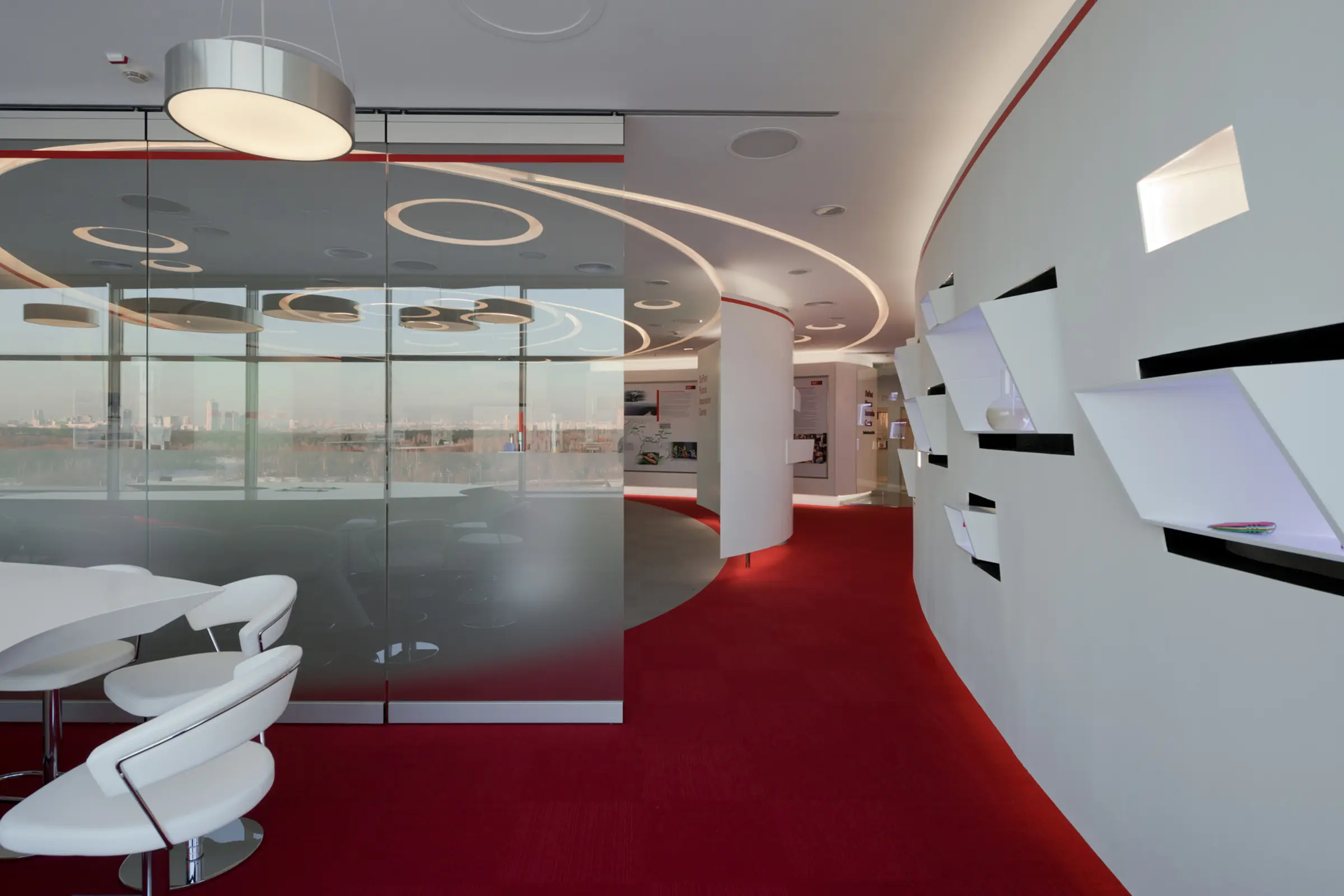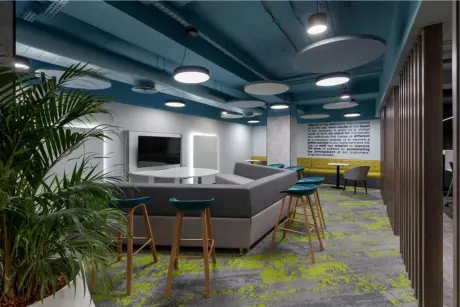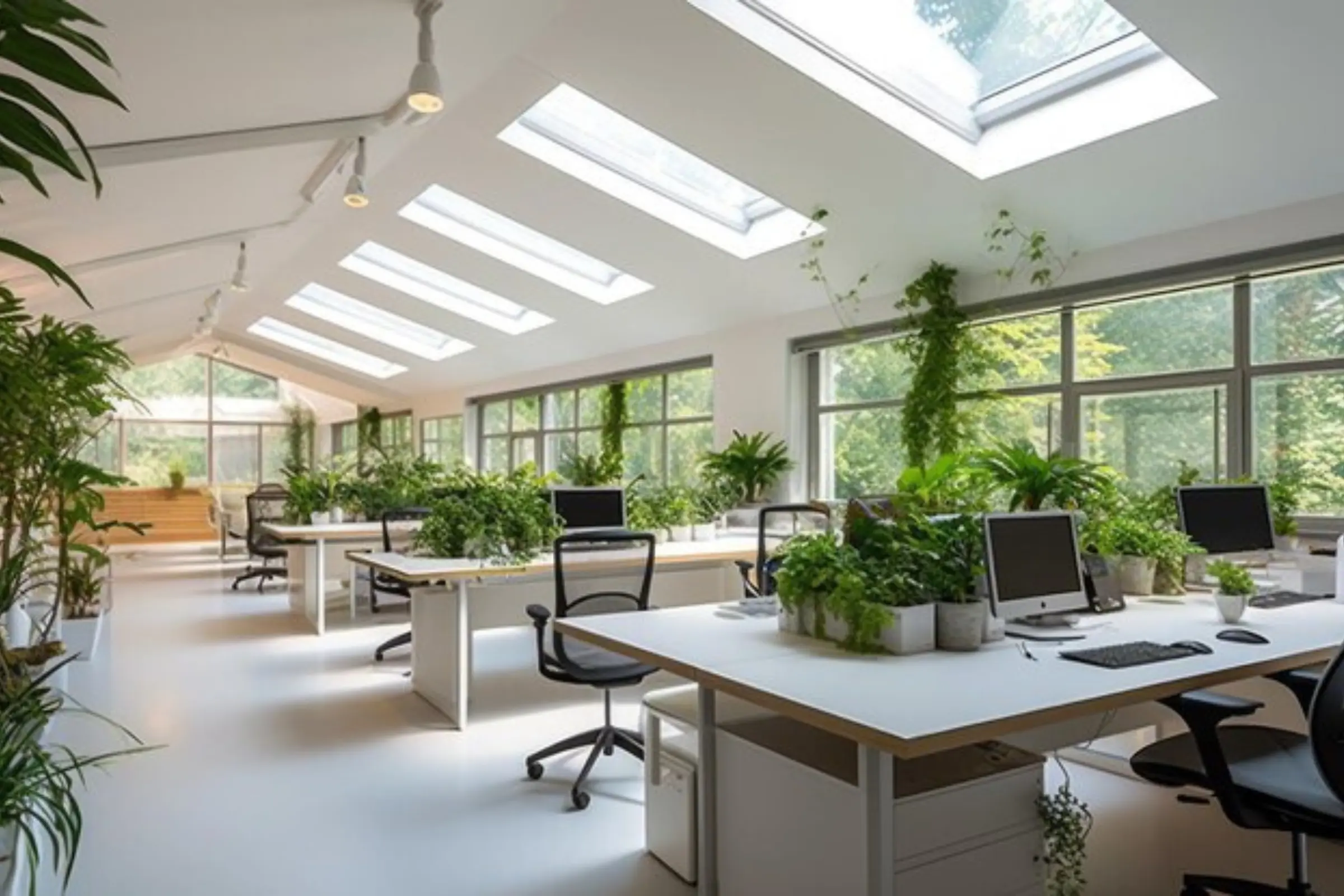
The year 2024 has been transformative for the corporate interior space with the myriad of trends that took over the year. 2025 is going to be yet another interesting year with corporate office design aimed at a rapid transformation. This massive shift will be influenced by several factors including workplace dynamics, technology advancements and an increased focus on employee wellbeing.
At Krayons, we believe that a workspace is not just a functional area but a hub of innovation, creativity and productivity. Over the years we have seen trends come and go while we successfully implemented the best of them in designs for our global clients.
In this blog, we will decipher the upcoming corporate interior trends for 2025 and give you insights on how to implement them in your corporate interiors. Stay tuned as we help you leverage the latest trends to stay ahead in a competitive landscape.
1. Hybrid Workspaces
2020 altered the world as we know it and corporate life has also been altered ever since. At the peak of the pandemic, workplaces embraced a fully remote approach that gradually faded into partially remote and now hybrid. As organizations prioritize flexibility - hybrid workspaces are the new norm in 2025. Corporate offices are now designed to be more adaptable and flexible blending in-office productivity and at-home comfort. These spaces support collaboration, innovation, and flexibility for teams that may not always be physically present together.
Companies are focused on creating flexible spaces for work like collaboration pods, and meeting rooms fitted with high-quality video conferencing technology. The idea is to create spaces that are facilitative to support both deep work on an individual level and group interactions. This hybrid setup will empower employees to move seamlessly between different types of work, irrespective of whether they are physically at the office or home.
Design Tip from Krayons: Think of ways to add modular furniture to your interiors, This will allow easy reconfiguration of spaces depending on your team size and needs.
2. Tech Integration in Office Design
A decade ago, offices looked very different from what they look like today and a decade from now, it will be a similar case. Workspaces are constantly evolving and technology seems to be a constant in shaping how we work. Tech integration in office interiors is yet another trend that will shake 2025. Smart offices will no longer be a thing of the future but a reality of every modern office. These offices will integrate comfort with convenience and ensure maximum efficiency to both employers and employees.
From automated lighting systems that adjust based on natural light levels to temperature control that learns the preferences of employees, technology is enabling a more personalized and responsive workspace experience.
IoT (Internet of Things) is yet another advancement that is keenly followed in the corporate interior space. IoT includes intelligent sensors to track room occupancy, air quality, and energy usage. These data-driven insights can help optimize office layout, improve employee comfort, and reduce energy costs.
Integration of AI tools to assist with day-to-day tasks, as well as seamless video conferencing technology, is also creating more connected and efficient environments.
Design Tip: A simple way to integrate tech into your workspace would be to add small changes like built-in charging stations, motion-sensing lights, and smart desks that adjust for height. Hidden tech can easily be incorporated into workspaces to ensure technology enhances the workspace without overwhelming the design.
3. Sustainable Work Environments
Sustainability is easily one of the most talked about topics. However, not everyone understands the finer details of including sustainability in workplaces. As the world grapples with issues like climate change, sustainability is no longer an option but an imperative for employers and employees. Integrating sustainable design and technology into workspaces is only the start, but a good step in the right direction.
Organizations can start taking steps towards sustainable design by using eco-friendly materials, implementing energy-efficient systems, and prioritizing natural light and ventilation. Furthermore, the usage of recycled and upcycled furniture, biodegradable materials, and low-emission paints and finishes is a good starting point.
Design Tip: Materials with a low carbon footprint (bamboo, reclaimed wood, or natural stone) are a better option. You can also choose energy-efficient lighting and climate control systems to reduce environmental impact.
4. Biophilic Design
The concept of green spaces has already existed and it is no secret that adding a touch of nature to interiors has its positive effects. Biophilic design in corporate interiors has gained significant popularity in recent years, and its influence will continue to grow in 2025. Biophilic design integrates bring elements of nature into the workspace to improve the well-being of employees.
This is usually achieved through the incorporation of natural materials, such as wood, stone, and plants, as well as maximizing natural light and outdoor views.
Research claims that biophilic design has an immense positive impact on employee productivity, creativity, and reduced stress levels. Offices that incorporate natural elements into their spaces help create a sense of calm and connection to the environment, fostering a balanced and energized workplace.
5. Wellness-Focused Spaces
In 2025, businesses are investing in the wellness of their employees. This is in terms of the spaces as well
Placing greater emphasis on the health and wellness of their employees. Wellness-focused design elements are becoming integral to corporate interiors, with spaces dedicated to relaxation, physical activity, and mental well-being.
Dedicated wellness rooms, fitness areas, and mindfulness zones are gaining popularity, allowing employees to take breaks and recharge during the workday. Ergonomic furniture, standing desks, and adjustable monitors are also becoming essential to support physical health and reduce workplace strain.
Design Tip: Create dedicated spaces for meditation, yoga, or fitness classes. Invest in ergonomic furniture that supports good posture and well-being, such as sit-stand desks, lumbar support chairs, and anti-fatigue mats.
6. Personalization and Customization
As more companies prioritize employee engagement and retention, creating a workspace that feels personalized and comfortable has become crucial. Employees are seeking an environment where they feel like they belong, and companies are responding by offering customizable workspaces. This can range from adjustable desks to personal storage units and even the ability to personalize workstations with décor or artwork.
Personalization also extends to the layout and atmosphere of the office. Open-plan offices are being balanced with private spaces, allowing employees to tailor their work environments to their preferences.
Design Tip: Allow employees to personalize their workstations with their favourite colours, artwork, or plants. Create areas that cater to different working styles—whether that’s quiet spaces for deep work or collaborative hubs for teamwork.
7. Inclusive Design
Inclusion and diversity will remain top priorities for businesses in 2025. This commitment will continue to be reflected in office design. An inclusive office is required to cater to the needs of a diverse workforce, including people with disabilities, those with different working styles, and employees from various backgrounds.
Inclusive design ensures that your offices are accessible to every individual from any walk of life. This includes providing ramps and elevators to create quiet spaces for neurodiverse individuals. Flexibility in office layouts also supports diverse working needs, allowing for quiet, collaborative, or social spaces as necessary.
Design Tip: Ensure that the office is fully accessible, with wide doorways, ramps, and seating arrangements that cater to people with disabilities. Create multi-functional spaces that can be easily adjusted for different team sizes and activities.

Conclusion
As we step into 2025, we can assure you that the landscape of corporate interiors will continue to evolve with changes in the way we work, with the advent of technology and the rising focus on employee well-being. Amidst all these changes, one thing remains constant - the need to understand trends and keep up with the speed of the evolving landscape. At Krayons, we understand the pulse of changing trends as much as we understand the evolving needs of our customers. We aim to continue embracing these upcoming trends as they come and add to it our own twist of creativity and innovation.


